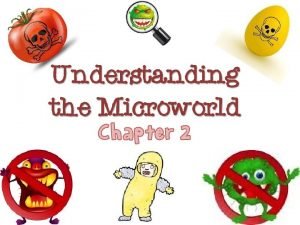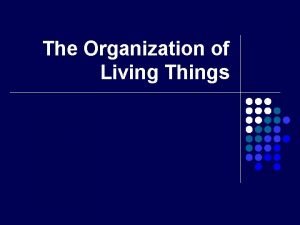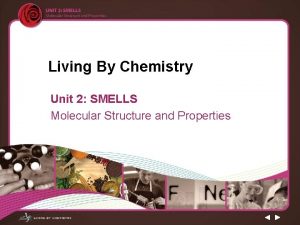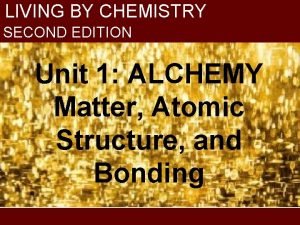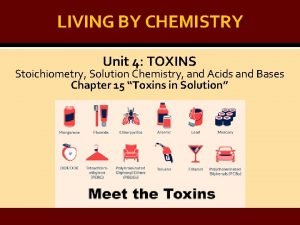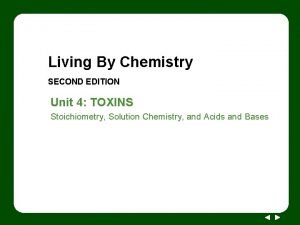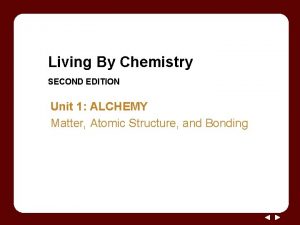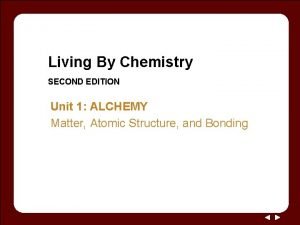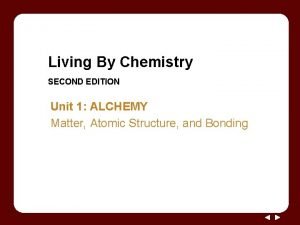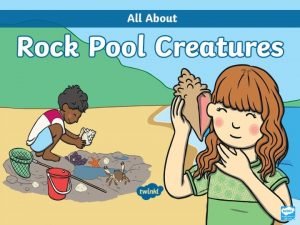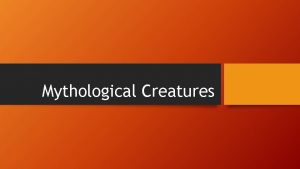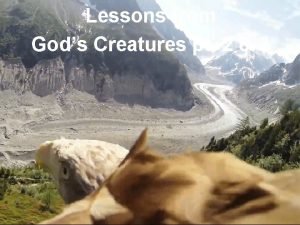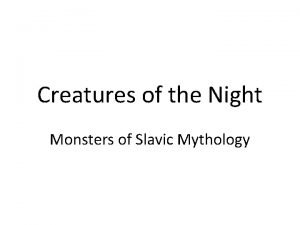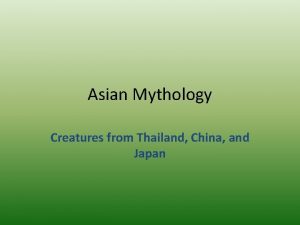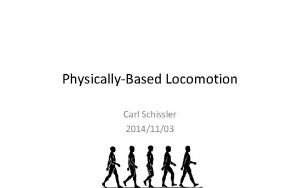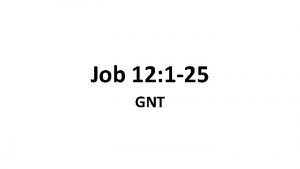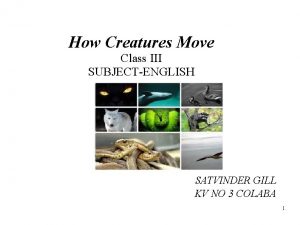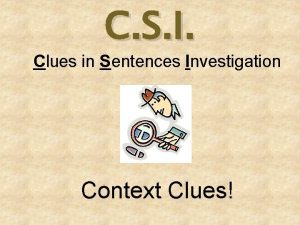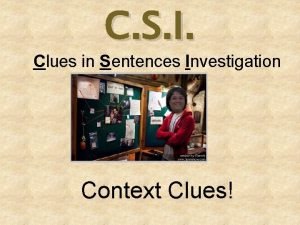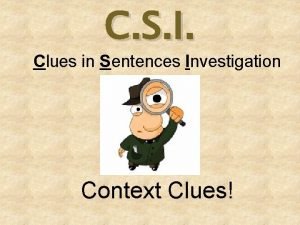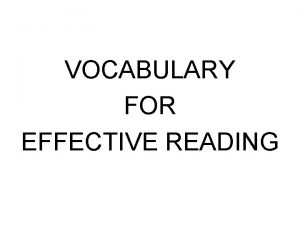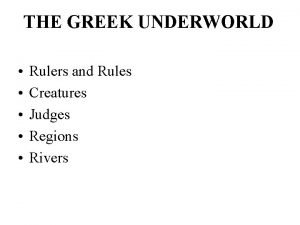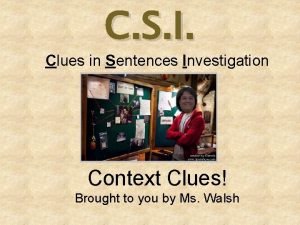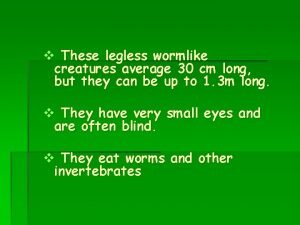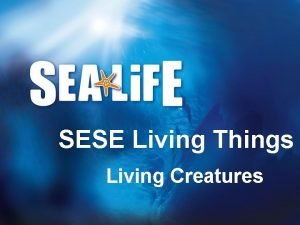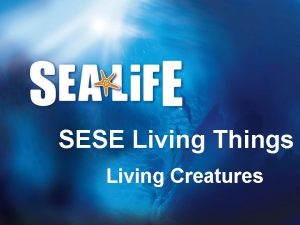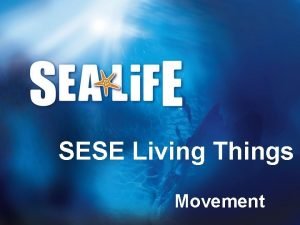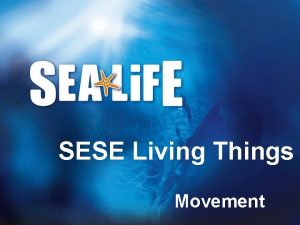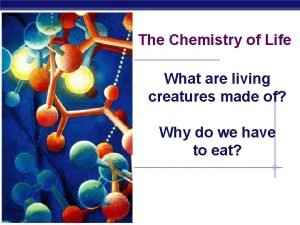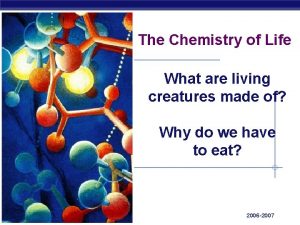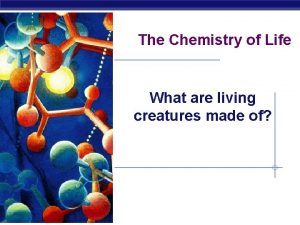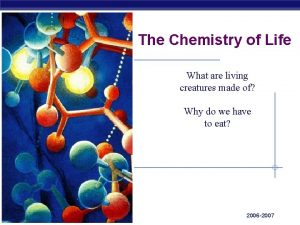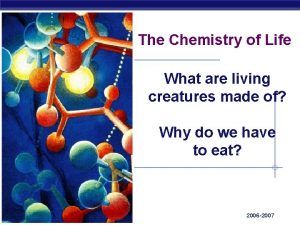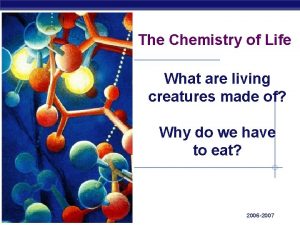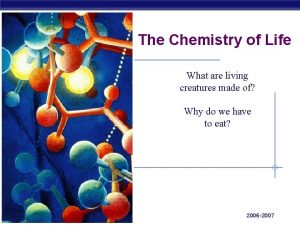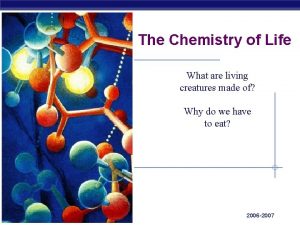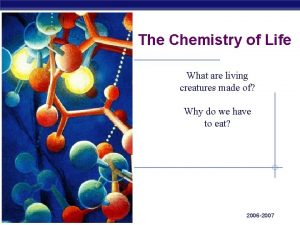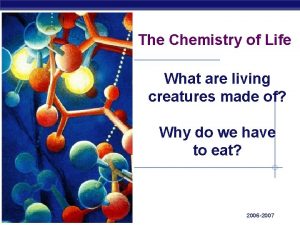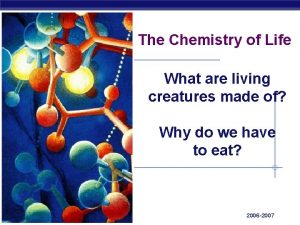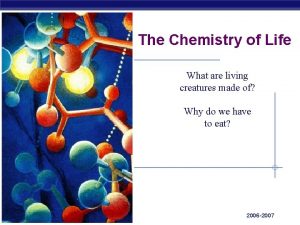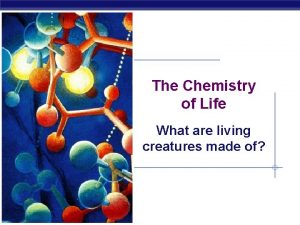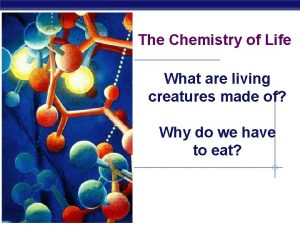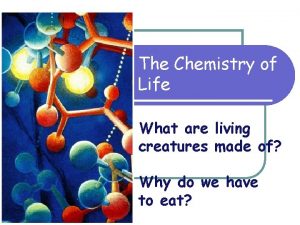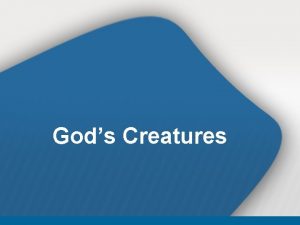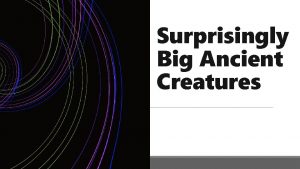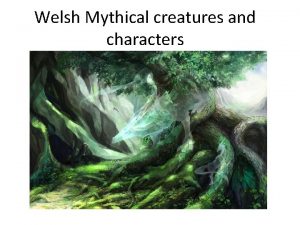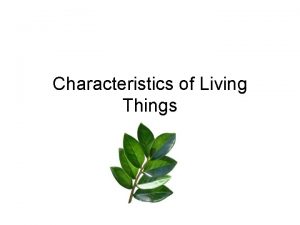The Chemistry of Life What are living creatures




































- Slides: 36

The Chemistry of Life What are living creatures made of? Why do we have to eat?

ORGANIC CHEMISTRY

Organic Chemistry � Definition… The branch of chemistry that studies carbon and its compounds

Elements of Life § 96% of living organisms is made of: n n carbon (C) oxygen (O) hydrogen (H) nitrogen (N) Regents Biology

Organic compound A compound that contains carbon and hydrogen bonded together. Example: glucose—C 6 H 12 O 6

Inorganic compound A compound that does not contain carbon Example: H 2 O Na. Cl

All organisms are organic. In other words, all organisms are carbon based.

Molecules of Life § Put C, H, O, N together in different § ways to build living organisms What are bodies made of? u carbohydrates § sugars & starches proteins u fats (lipids) u nucleic acids u § DNA, RNA Regents Biology

The Major Organic Compounds • Carbohydrates • Lipids • Proteins • Nucleic Acids large Macromolecules— very large molecules

Don’t forget water § Water 65% of your body is H 2 O u water is inorganic u § doesn’t contain carbon § Rest of you is made of carbon molecules u organic molecules § § Regents Biology carbohydrates proteins fats nucleic acids

Why do we eat? § We eat to take in more of these chemicals u Food for building materials § to make more of us (cells) § for growth § for repair u Food to make energy § calories § to make ATP Regents Biology ATP

Vocabulary woohoo! 1. polymer— a molecule made of many repeating smaller molecules 2. monomer— each one of the repeating smaller molecules

Building large organic molecules § Small molecules = monomers (building block) § Bond them together = polymers Regents Biology

Macromolecules and basic units Macromolecule Basic unit Carbohydrate Monosaccaride Protein Amino acid Lipid Fatty acid Nucleic acid Nucleotide

Building important polymers Carbohydrates = built from sugars sugar – sugar – sugar Proteins = built from amino acids amino amino acid – acid – acid Nucleic acids (DNA) = built from nucleotides nucleotide – nucleotide Regents Biology

THE CARBOHYDRATES

ELEMENTS FOUND IN CARBOHYDRATES • CARBON (C) • HYDROGEN (H) • OXYGEN (O)

The carbohydrates include… 1 • Monosaccharides one sugar molecule 2 • Disaccharides two sugar molecule many • Polysaccharides many sugar molecule Saccharide means “sugar”

The Monosaccharides • One sugar molecules • Recognized by their carbon ring

THESE ARE MONOSACCHARIDES Check out their carbon rings Glucose C 6 H 12 O 6 Galactose C 6 H 12 O 6 Fructose C 6 H 12 O 6 What makes these three molecules different from each other? The arrangement of their atoms

Compounds with the same molecular formula but different structures are called ISOMERS

The Disaccharides • Two sugar molecule • Two monosaccharides bonded together covalent bond holding them together monosac

Example of a Disaccharide Two monosaccharides bonded together

These are disaccharides • Maltose (glucose + glucose) • Sucrose (glucose + fructose) • Lactose (glucose + galactose)

• Monosaccharides and disaccharides are called simple sugars • What do you notice about the names of all the simple sugars? ─OSE = SUGAR

The Polysaccharides • Many sugar molecules bonded together by covalent bonds … etc.

These are polysaccharides • Starch • Glycogen • Cellulose • Chitin All made of repeating glucose molecules

Starch is a polysaccharide • Chain of glucose molecules • The form in which plants store food • So … starch is found only in plant products üPotatoes üRice üBread üCorn üPasta üetc.

Glycogen is a polysaccharide • Chain of glucose molecules • The form in which many animals, including humans, store food • In what organ do humans store glycogen? THE LIVER!

Cellulose is a polysaccharide • Chain of glucose molecules • Found in cell walls What kind of cells have a cell wall made of cellulose? Plant • Cellulose is what we commonly call dietary fiber or roughage

Chitin is a polysaccharide outside • Found in exoskeletons

Why do organisms need carbohydrates? SIMPLE SUGARS • Immediate energy— Are broken down during cellular respiration STARCH AND GLYCOGEN • Stored energy— Can be converted back into glucose when needed CELLULOSE AND CHITIN • Structure and Support— Gives shape and protection to plant cells Protects soft tissues of some animals

Carbohydrates: Food Sources • Simple carbs (simple • Complex carbs (like sugars) are found in starches) are found in most candy and sweet pasta, bread, drinks, fruit, potatoes, legumes & vegetables, and milk. corn. They take longer They are quickly to digest, and provide digested and give a energy longer. short burst of energy.

Carbohydrates: Function • Provide body with energy! Complex carb (ex. Starch) – What should you eat before playing the big game? Candy bar or pasta? • Candy bar: contains simple sugars, provides a short burst of energy • Pasta: contains starch which takes longer to break down, provides longer-lasting energy – *We can’t digest celluloseit is used as fiber, or roughage instead. Broken down to disaccharides Broken down further • Ex. : corn Simple sugars (ex. Glucose)

Carbohydrates: Indicator Tests • Simple Sugars: – Benedict’s solution – Blue solution turns orange/green/brown • Complex Carbs: – Lugol’s solution/Iodine – Turns from orange-red -brown to black-purple

Let’s Summarize Carbohydrates: 1. Monosaccharides – Glucose, galactose, fructose 2. Disaccharides – Maltose – Sucrose – Lactose 3. Polysaccharides – Starch – Glycogen – Cellulose – Chitin
 Mikael ferm
Mikael ferm Four living creatures covered with eyes
Four living creatures covered with eyes Small living creatures tom 20
Small living creatures tom 20 Small living organisms
Small living organisms Levels of organization atom
Levels of organization atom Venn diagram of living and nonliving things
Venn diagram of living and nonliving things Is moss living or nonliving
Is moss living or nonliving Living non living dead
Living non living dead The smallest living unit within the human body is
The smallest living unit within the human body is Living by chemistry unit 2 smells answers
Living by chemistry unit 2 smells answers Living by chemistry answer key
Living by chemistry answer key Living by chemistry solutions
Living by chemistry solutions What is catalystfive
What is catalystfive Lesson 81 drop in molecular views
Lesson 81 drop in molecular views Living by chemistry
Living by chemistry Living by chemistry
Living by chemistry Living by chemistry
Living by chemistry Ib organic chemistry functional groups
Ib organic chemistry functional groups Inorganic chemistry vs organic chemistry
Inorganic chemistry vs organic chemistry Rock pool creatures
Rock pool creatures Mythological creature half man half horse
Mythological creature half man half horse Gods creatures download
Gods creatures download Werewolf slavic mythology
Werewolf slavic mythology Puksa meaning
Puksa meaning Bulgarian mythology creatures
Bulgarian mythology creatures Carl schissler
Carl schissler Proverbs 25 gnt
Proverbs 25 gnt The lion walks on padded paws
The lion walks on padded paws Related words examples
Related words examples Example of definition/description clue
Example of definition/description clue Unbelievable sentence
Unbelievable sentence Emaciation context clues
Emaciation context clues Rules of the underworld
Rules of the underworld Goddess diana vesta
Goddess diana vesta Piscatorial creatures examples
Piscatorial creatures examples Legless creatures
Legless creatures Slow and steady wins the race find the predicate
Slow and steady wins the race find the predicate


